

By Mikhail Kuvyrko, Moscow — translated from Russian*
@bears_with
Entire sectors of the Russian economy have managed to earn huge amounts of money recently –and all thanks to the crisis caused by the coronavirus. Who has benefited the most from what is happening, will this cash flow continue in the future and what will the coronavirus excess profits be spent on as a result?
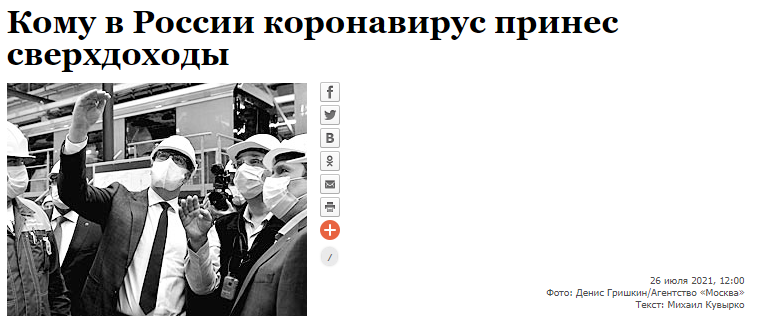
Click to read the Russian original.
A year and a half after the start of the pandemic, it can be argued that the catastrophic expectations of Russian business at the start of the crisis were only partially justified. The losses have undoubtedly been great: the service sectors of the economy have suffered the most, because it is very difficult to reduce personal interaction with customers to a minimum (for example, in restaurants and hotels).
However, the list of industries which have received significant profits is quite impressive. It is noteworthy that these are mainly sectors engaged in direct material production.
The most obvious example is, of course, the pharmaceutical companies and the manufacturers of medical products and health services. According to the Ministry of Industry and Trade, the production of medical masks alone has increased more than 30 times since the beginning of the pandemic – up to 19 million units, and the number of enterprises producing masks has increased from 18 to 86. The same explosive demand for their products was experienced by vaccine manufacturers.
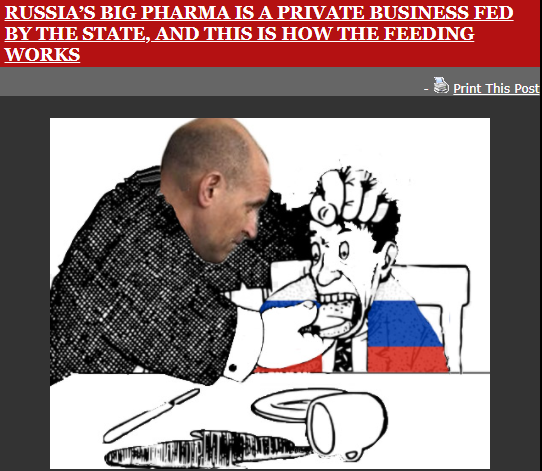
During the pandemic year of 2020, Dances with Bears has reported in depth on the lead business sectors. For more on the Russian pharmaceutical industry and the oligarchs who control it, read this.
Due to the appearance of new strains of coronavirus, there is no doubt that the pharmaceutical industry will continue to invest in the development and production of new drugs for the prevention and treatment of various infections, says independent expert economist Yelena Strogonova. In her opinion, it is possible to say with absolute confidence that this sector will develop further only in the direction of growth.
Roman Alyokhin, a specialist in social technologies, adds that pharmacy and medicine are among those areas where citizens have formed the expectation of price growth – and business is justifying this expectation. Accordingly, the expert believes the tendency to increase margins in these areas will continue, not only due to the monopolization of markets by the large companies, but also due to the constant increase in demand for their products and services. “People are scared of the coronavirus; they run to the doctor with every sneeze; and since state institutions are working less and less efficiently, citizens go to private specialists,” the expert says.
Among the sectors which have been able to make super profits over the past year and a half, commentators also often name Russian metallurgy, which has taken advantage of increasing metal prices on the world market. A good example is the rise of Severstal shares by 112% over the year, Gulnara Ruchkina, dean of the Law Faculty of the Financial University under the Government, gives an example. According to her, investors’ bets on the metallurgical sector are related to the global trend of renewed interest in commodity markets.
STEEL PRICE TRAJECTORY IN THE GLOBAL MARKET, REINFORCEMENT BAR (REBAR), 2016 -2021
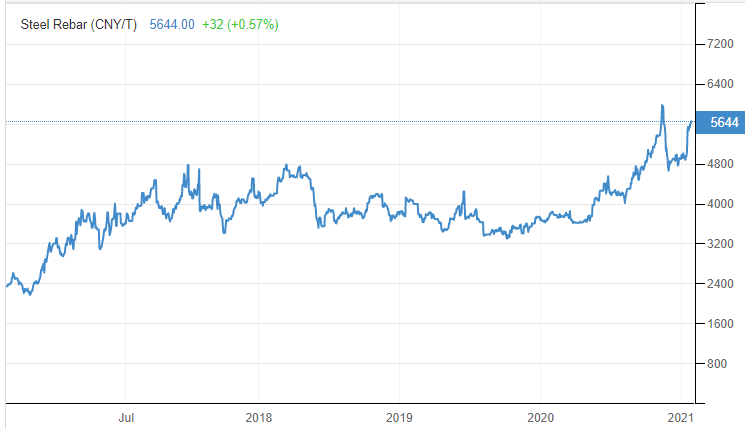
Source: https://tradingeconomics.com/
The unit price is Chinese yuan per metric tonne as traded on the Shanghai Futures Exchange.
SHARE PRICE TRAJECTORY OF LEADING RUSSIAN STEELMAKERS, JULY 2020-JULY 2021
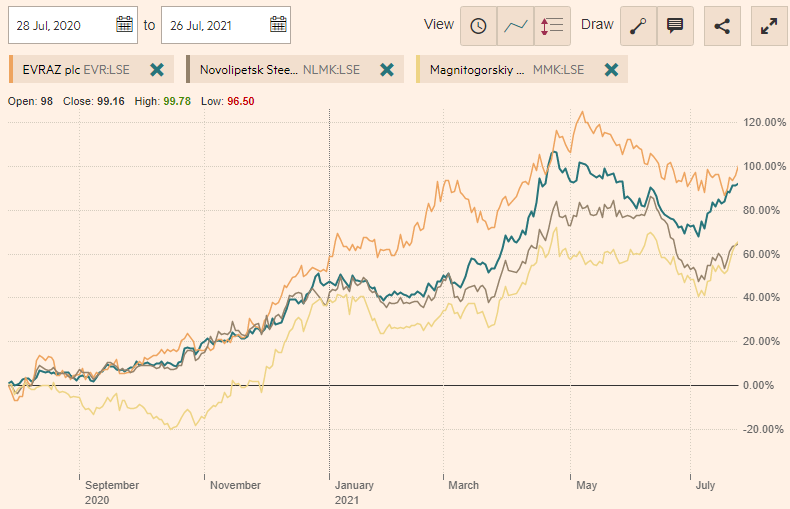
KEY: Orange=Evraz (owned by Alexander Abramov); grey=Severstal (Alexei Mordashov); brown=Novolipetsk Steel (Vladimir Lisin); yellow=Magnitogorsk MMK (Victor Rashnikov). Source: https://markets.ft.com
The biggest winners during the crisis were gold mining companies, according to Karman Gulamov, chief executive of AKFA Group. Last year, according to him, the largest gold producer Polyus became the leader in terms of the profitability of Russian shares – its securities showed an increase of 116%, and Polymetal was also in the top five (+73%).
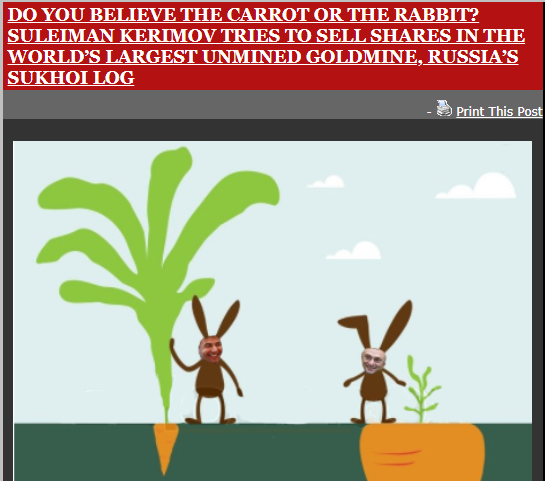
Polyus, the Russian goldmine leader, is controlled by Suleiman Kerimov. Read more: http://johnhelmer.org/
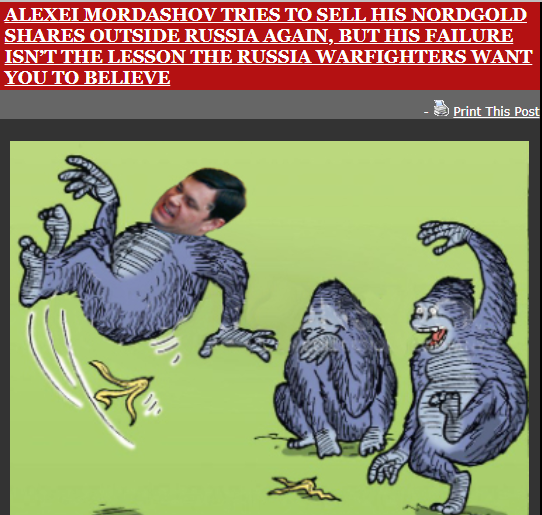
Read more on the Russian goldminers: http://johnhelmer.org/
In addition, the expert adds, the front-runners on the Moscow stock market last year were the shares of Yandex (+89%) and the pharmaceutical holding Binnopharm Group, which is engaged in the production of drugs for the treatment of coronavirus and the Sputnik V vaccine. The list of the most profitable securities also includes shares of the Magnit grocery chains (+58%) and X5 Retail Group (+29%) – their share prices were pushed up by increased demand for food products in the context of the pandemic and the suspension of cafes and restaurants.
The transition of Russians to cheaper products and goods has stimulated the development of a new segment of retailers – super-discounters like the Traffic Light network, which is showing rapid growth, adds the head of the VBC Group, Semyon Tenyaev. In his opinion, such an approach, minimizing the cost of servicing consumers and thereby maintaining the lowest prices, is now in great demand not only in food retail, but also in other consumer areas.
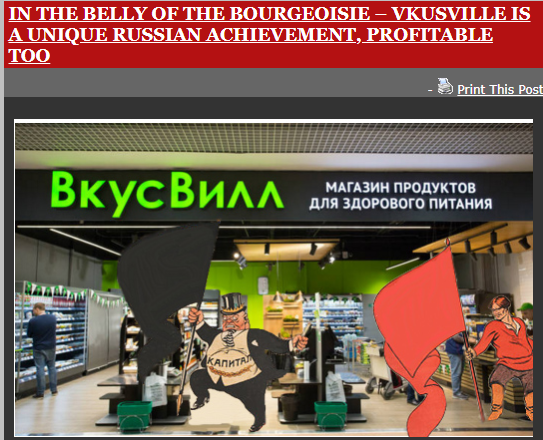
Read more on Russian food retailers here: http://johnhelmer.org/
Predictably, agriculture and the food industry are included in the list of industries whose experience of the crisis has been successful.
Whatever happens in the Russian economy, the demand for food will always remain, and its producers are rapidly adapting to the new realities; this pattern is well-known and has been repeatedly confirmed in practice. “The work of the agricultural and food sectors did not stop, unlike other sectors of the economy,” recalls economist Strogonova. “Despite the fall in consumer demand, both these sectors are doing very well due to the increase in prices for their products. Even with a drop in income, the consumer will choose food products according to the scope of his basket.”
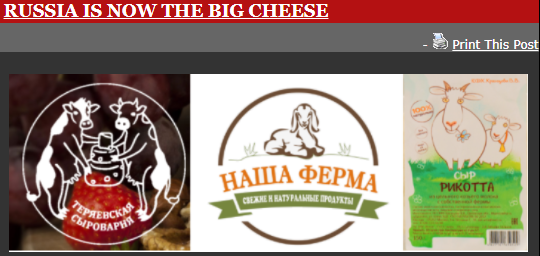
Source: http://johnhelmer.org/
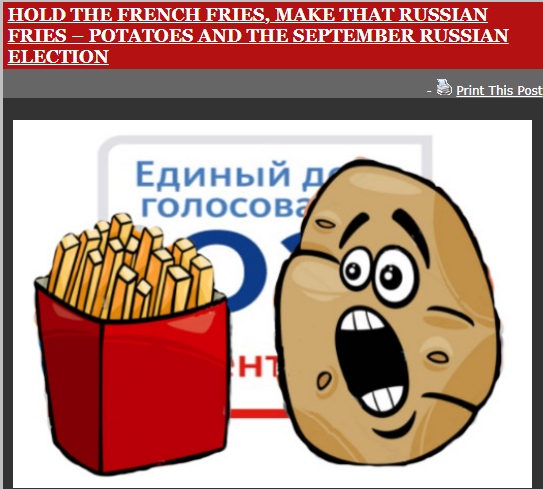
Source: http://johnhelmer.org/
An additional incentive for manufacturing companies, the metals producers, and the food industry, along with the agro-industrial complex, has been the increased demand for their products in foreign markets. As a result, Irina Zezyukova, a specialist of the Consulting Center on Economic Problems, notes that the revenues and profits of those sectors of the Russian economy which have export sales have grown particularly strongly. At the same time, due to the change in the lifestyle of Russians and the growth of social problems in the country, the expert adds, the revenues and profits of producers of goods which are substitutes for sanctioned products (for example, cheese and fish), musical instruments, sports simulators, climate control equipment, building materials for repairs, together with rising demand for alcohol – the producers of these things, notes Karman Gulamov, show increased sales volumes, including through exports to Europe, by a rate of 10% to 20%.
A lot has been said about how powerful the coronavirus crisis was for the Russian IT sector, but we should not forget that it still remains within the service sector, providing “traditional” sectors with new development tools. Ultimately, the success of IT signals the restructuring of the real economy, which in any case will employ many more people than in high-tech companies. However, some long-established sectors have taken decisive steps themselves over the past year and a half to become the main customer for IT innovations.
A typical example is the financial sector, which during the pandemic turned out to be in an absolute boom both in terms of gross income and of profit, says Viktor Mironov, managing director of the TIM consulting group. The transition of transactions to electronic form and the increase in transactions with cards allowed banks and investment companies to both increase revenues and to reduce costs, making staff redundant, and closing offices that have become surplus to the new requirements, the expert notes. According to the Fitch rating agency, last year the Russian banking sector increased its profit by more than 20% – to 1.6 trillion rubles [$22.1 billion].
Another example of the transformation of traditional segments of the economy is the development of food and grocery delivery services, which are rapidly expanding their business. The Delivery Club network reported an increase of 1.8 times [revenue] in the first quarter; the product delivery service Sbermarket grew six and a half times — the co-founder of the service Andrei Priobrazhensky gives examples in his website promkod.ru . According to him, in this area the profits received will be actively invested in development; for example, Yandex plans to invest up to $ 500 million this year in its delivery service lines — Market, Shop and Food.
“What can be done without interpersonal contact is coming to every area of business,” comments Margarita Bylinina, head of the Digital Academy of Marketing, on the new trend. “The pandemic has shown that it is impossible to be purely offline for business, hence the popularity of online solutions – cloud services, CRM [customer relationship management] systems, digital marketing and online promotion. This is especially true for small and medium-sized businesses which need to be closer to their customer base, so social networks come out on top here. Also, artificial intelligence and neural networks are often used to communicate with customers and configure advertising. Progress in these areas will continue for a long time, at least until 2030. The crisis creates a situation where the paradigm of behaviour cannot remain the same: the rules of the game are changing, and everyone will have to accept the new reality.”
The steady growth of the IT market will be observable for at least another three to five years, adds Oksana Pokrovskaya, development director of the investment company GLS Invest. As examples of promising new customers for the IT companies, she cites the large clinics actively developing tele-medicine; language schools which go online, because this allows expanding the geography of the customer base and recruiting more students; as well as all segments of retail trade. Last year, online stores added customers over the age of 55 to their customer base, and even after the restrictions were relaxed, not all age-related customers returned to regular stores and shopping centres. “Every business needs to take note of this trend and digitalize – the trend will remain as stable as possible,” Pokrovskaya summarizes.
Finally, everyone who is related in one way or another to the field of residential real estate has managed to make money from the crisis – from construction companies and manufacturers of building materials to individual citizens and sole entrepreneurs engaged in repairs, and to private investors in square metres of realty assets. The sharp increase in the cost of housing which has occurred in recent months due to a complex of reasons — from the devaluation of the ruble to the government program of preferential [subsidized] mortgages — has led to higher prices in many segments of goods and services related to the real estate market.
But it is here, experts believe, that the profits may be one-off, and the rapid growth to date may soon be replaced by a recession. Last year’s package of anti-crisis measures of the government attracted more than 2 trillion rubles [$27.7 billion] to the construction industry, so the future dynamics of housing prices will depend on new incentives, says Dmitry Burmistrov, founder of the investment and collateral platform Red Gin. If there are no significant state support measures, then it is probable the growth rate of the cost of apartments will decrease by the end of the year because the falloff in demand is considerable. This year, revenue growth in the real estate sector is not expected to be comparable to last year, but it is unlikely there will be a significant decline in profits or a sharp decline in housing prices, Strogonova forecasts.
Effective investment of earnings earned during the crisis is becoming one of the most important issues of Russian economic policy. The fact that some companies were able to receive windfall profits as a result of a sharp increase in world export prices has become the occasion for the country’s leadership to think about incentives for the management of these companies to make strategic decisions in favor of reinvesting the profits received, rather than paying dividends to shareholders, comments Dmitry Panov, chairman of the St. Petersburg regional branch of Delovaya Rossiya. The most obvious example is metallurgy: it is enough to recall that not so long ago, the First Deputy Prime Minister of the Russian government, Andrei Belousov, made a point of commenting to the representatives of the industry on the excessive profits they earned due to the growth of world metal prices.
However, in practice, it is not so easy to dispose of excess profits. The same metallurgists, says the head of the Russian-Asian Union of Industrialists and Entrepreneurs Vitaly Mankevich, do not see favourable prospects for the implementation of projects within their own sector. To produce twice as much metal, there should be twice as many construction projects in the country, and exports are not so easy to increase. That is why metallurgists have recently been investing in retail, tourism, agriculture, and other industries.
Of all the industries which were able to earn in the black during the crisis, stable trends in income growth are observed only in IT and pharmaceuticals, Mankevich believes. The first of these industries has become the epicenter of the global technological revolution – the coronavirus crisis has accelerated total digitalization. The second, pharmaceuticals, is supported by global and Russian trends towards population aging. As for the banks which have earned well in the last year out of construction, the expert reminds, they depend in particular on state support for subsidizing mortgages; and in general on the interest rate policy of the Russian Central Bank. That is now tightening its approach — loan rates are rising, mortgages are being curtailed. So Russia’s industries are heading for a new cyclical crisis.
[*] Mikhail Kuvyrko is a regular reporter for Vzglyad and Expert.ru. The illustrations in this piece have been added from Dances with Bears and other sources.











Leave a Reply